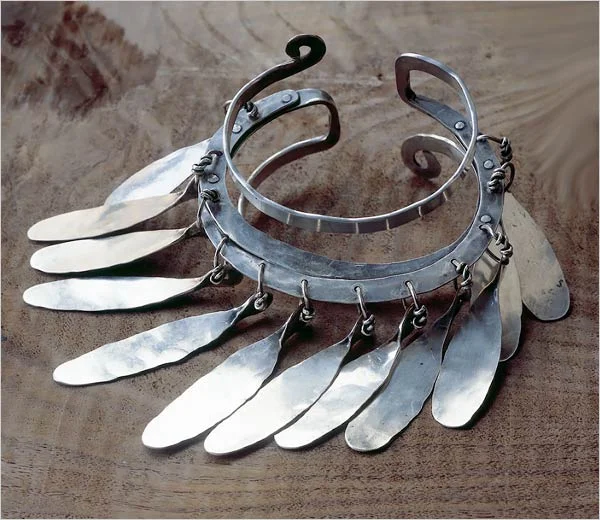Calder’s World
/Alexander Calder, Jealous Husband Necklace, 1940
At the entrance of Alexander Calder’s jewelry exhibition at the Metropolitan Museum of Art is “the Jealous Husband” Necklace. A seemingly witty reference to chastity belts, the piece sports spikes across the neck opening to stave away potential suitors. This necklace encapsulates the spirit of Calder’s jewelry, which appears witty and whimsical yet, at times, reads as constricting. Suggestions of boundedness and containment seem to transpire in some of the pieces—particularly a number of chocker-style necklaces. These are overlaid with Surrealist influences, as well as references to medieval and non-Western jewelry traditions.
Alexander Calder, Silver Bracelet, 1948
The majority of Calder’s jewelry pieces are reminiscent of his work with wire. Some, like a number of pieces on display a short walk away at the Whitney Museum of American Art, are abstract representation of animals through a continuous sculpted line. Other pieces make more subtle references to the rest of his oeuvre: some of the jewelry pieces are reminiscent of the ankle and arm bracelets worn by Josephine Baker in her Parisian performances, while the pointed wire structures Calder devised to represent Baker’s breasts resurface here in a bracelet. (It is interesting to note how Calder’s rendition of Baker’s breast is highly reminiscent of Jean Paul Gaultier’s conical bra, famously worn by another era’s pop star, Madonna, in the early 1990s. One is left to wonder whether Gaultier might have been directly influenced by Calder’s work. )
Alexander Calder’s “Josephine Baker IV"
Additionally, much of the jewelry entered the realms of wearables, as with a chain mail necklace, which in its size and shape is more akin to a see-through metal “waistcoat” than a necklace (and, once again, brings to mind later fashion designs: Paco Rabanne’s chain mail wearables from the 1960s). Also, of notice are a number of hats and tiaras, which show Calder’s interest in clothing and garments, in addition to jewelry. This interest is perhaps most evident in the circus exhibition at the Whitney, where one can admire the beautifully and painstakingly rendered miniaturized clothes the artist created for the circus’ performers. And, at least in one instance, the clothes take center stage as one of the performers is revealed to be wearing an innumerable numbers of jackets in a Russian doll-style disrobing act, which is part of Calder’s circus performance.
Francesca Granata








